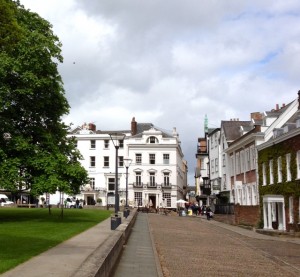It was always so easy to hurry on past Exeter, on the way to the seaside resorts of Devon and Cornwall. But there are good reasons to resist the siren call of the beach, at least for a while. My list of the things to see and do in this ancient Devon city include Britain’s prettiest cathedral, one of the world’s narrowest streets and a prince’s prize-winning museum. And there are free, daily guided walks too.
Gothic glory
Exeter’s cathedral in the Decorated Gothic style, with twin, stout Norman towers, is the distinguished central feature of this old city, alongside elegant Regency terraces. Begun in 1112, it has the world’s longest (300 ft) unbroken Gothic ceiling – compared to an avenue of stately trees. The magnificent west front features sculptures of some very weathered monarchs – Alfred, Athelstand, Canute and Willliam the Conqueror, sitting informal and cross-legged as if they are chatting. There’s an excellent cafe, under a fabulous vaulted stone ceiling and 18th century stained glass windows. This is a good place to try the famous Devon cream tea. The illustrious choir sing at evensong, Monday to Friday. Admission to the cathedral is £6. www.exeter-cathedral.org.uk

